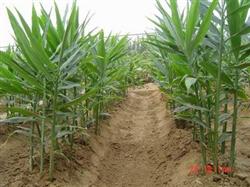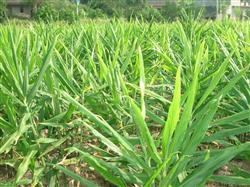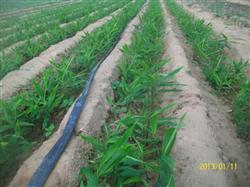Cultivation techniques of Ginger softening

The softening cultivation of ginger is on the basis of normal cultivation, one is to increase the cultivation density and strengthen the measures of shading and cooling, so as to achieve the purpose of harvesting tender ginger. In this way, tender ginger not only has a long harvest time, high yield, but also fresh and crisp, thin skin and sparse skin, and has a delicate ginger flavor when eating. 1. Site selection: choose fertile soil that has not planted ginger for 3 consecutive years. 2. Seed selection: choose fresh ginger with large pieces, many buds and no diseases and insect pests. 300 kg of ginger is needed for every 667 square meters. 3. Ginger seed treatment: first soak the ginger seeds in 40% formalin solution for 30 minutes, then soak the ginger seeds in sacks for 3-6 hours, then dry them for 2 days, turn them once every morning and evening, and then pile them in the house for 4 days, keeping the temperature at 15 ℃. This repeated drying and stacking for 3 times is beneficial to the germination of ginger seeds. 4. Sprouting: spray the air-dried wheat husk and grain husk with 1% lime water (70% humidity is suitable), and spread 10 cm thick on the floor in the shed as a cushion. After drying the ginger seed for the last time, place the ginger seed on the cushion while the ginger seed is still hot, arrange it layer by layer, heap 1 meter high, cover the top layer with 5 cm thick clean straw, and then cover with plastic film or plastic film, keep the temperature at 20 ℃ and humidity at 75%. When the ginger bud grows to 1 cm, it can be sown and planted. 5. preparation before setting: first cut the budding ginger into pieces, leaving 2-3 buds in each piece, and then dip the incision in fresh plant ash, one is to disinfect, and the other is to supplement potassium nutrition. Then prepare the land and make beds, applying 5000 kg of high-quality coarse fertilizer every 667m2, turning the soil into centimeters after general fertilization, making a 1-meter-wide border after leveling the land, then covering the plastic film baking land, and planting when the local temperature is stable above 15 ℃. 6. Planting: planting in trenches according to row spacing of 50 cm and plant spacing of 15 cm, with 2 rows per row. When planting, the bud tip faces south, with the depth of the bud tip flush with the surface, then spray warm water to wet the ginger piece, then cover a thin layer of fine sand, cover the bud tip of Yan ginger as the degree, and then cover with plastic film to keep warm and moisturize to promote bud growth. 7. Field management: control the bed temperature above 15 ℃ before seedling emergence, and properly shade and prevent strong light after seedling emergence. When ginger seedlings grow out of 3 sides, they should be fertilized and watered, 1000 kg of 50% manure and 10 kg of urea every 667m2, and topdressing every 20 days during the peak period of stem and leaf growth. 8. Disease and pest control: the disease of ginger is mainly ginger plague. Ginger plague can be disinfected with compound ginger plague 200 times liquid. At the initial stage of the disease, compound ginger plague Jing 200 liquid is used to irrigate the root every 10 days, with a dosage of 300 kg per 667 square meters. The main pests harmful to ginger are ginger borer and ground tiger, which can be controlled by spraying 90% trichlorfon 800 times every 10 days. 9. Softening measures: first, cultivate soil and soften. Generally speaking, after each topdressing, the ginger root should be cultivated to prevent lodging and promoting ginger softening. After 3 or 4 times of soil cultivation, the ginger border will gradually become a ginger ridge, which can further promote ginger softening. Second, sunshade softening. Before the advent of the high temperature season, put up a sunshade on the ginger ridge and cover the sunshade net to prevent the strong light from directly shining on the ginger seedlings, which can cool and moisturize, and also play the role of shading and softening. Ginger cultivated by softening is not suitable to harvest mother ginger, but only tender ginger. It is generally sown in April, and tender ginger can be harvested in August until the end of October. 3000 kg of tender ginger is produced per 667m2.
- Prev

High-yield cultivation techniques of interplanting watermelon with ginger
When planting ginger, heavy application of base fertilizer and application of phosphorus and potassium fertilizer should avoid applying more nitrogen fertilizer. Apply sufficient base fertilizer, mainly organic fertilizer, long-term and short-acting chemical fertilizer. Base fertilizer generally accounts for 40% of the total fertilizer application. Before sowing, 15 kg of imported compound fertilizer and 50 kg of calcium magnesium phosphate fertilizer can be used as deep base fertilizer per mu. Use high-quality soil and miscellaneous fertilizer after sowing.
- Next

Skillfully applying nitrogen fertilizer to ginger has high quality and high yield.
According to the law of ginger absorption, reasonable application of suitable varieties of nitrogen fertilizer can greatly increase the yield, improve the quality, increase the content of starch, protein and volatile oil of commercial ginger, and decrease the content of soluble sugar and cellulose. In four kinds of nitrogen fertilizers: ammonium bicarbonate, sodium nitrate, urea and ammonium nitrate, sodium nitrate had effect on seedling growth.
Related
- Where is it suitable to grow horseradish in China? it is expected to see the middle altitude horseradish in Alishan.
- How to prevent tomato virus disease reasonably? (Control methods included)
- Many people like to plant towel gourd on the balcony. What are the main points of this method and management?
- What crops can chili peppers be mixed with?
- Fertilization techniques and matters needing attention in Tomato
- What are the grafting techniques for peach seedlings in spring?
- Harm and control methods of root swelling disease of Chinese cabbage
- What are the pests of sweet potatoes? How to prevent and cure it?
- Symptoms, causes and Control methods of navel Rot in Tomato
- The cause of "Cucumber rotten bibcock" in Farmers' planting Cucumber and its Control Plan

